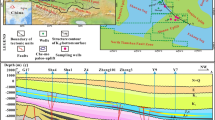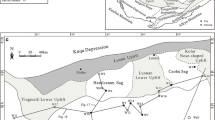Abstract
The Chang 9 interval at the lower part of the Upper Triassic Yanchang Formation in the Ordos Basin is a new discovery sequence for strategy replacement in the oil exploration field. By conducting a comprehensive study of outcrop sections, well drilling, drill cores, well loggings, and test data, based on the relevant research achievements of some predecessors, and combined with the analysis of geological background of this basin, it is considered that the Ordos Basin is a broad and shallow lake basin with terrigenous clastic deposition during Late Triassic Chang 9 time. The lake basin had been supplied with multiple drainage systems and provenances. The lake water in this basin is inland freshwater to brackish water. Sedimentary framework is characterized by the development of “a lake surrounded by multiple deltas” pattern. On the basis of paleocurrent analysis, distribution of sedimentary facies and sand bodies, and the quantitative analysis results of rock fragment components and trace elements of Chang 9 sandstone, it is recognized comprehensively that the Chang 9 provenances have a close connection with the basin tectonic evolution and paleogeographic background. The provenance of the Ordos Basin in Chang 9 time can be divided into five provenance systems: i.e., the northeast, north, northwest, southwest, and south provenance systems. Characteristics of rock fragment and trace element assemblages are documented in the individual provenance systems, respectively. It is inferred that terrigenous clastic sediments in Chang 9 interval mainly originate from the old lands around the basin. Parent rocks in these provenances are composed of a variety of rocks dominated by metamorphic rocks.






Similar content being viewed by others
References
Abhik K, Abdul M, Malay M (2012) Depositional environment and provenance of Middle Siwalik sediments in Tista valley, Darjiling District, Eastern Himalaya, India. J Earth Syst Sci 121:73–89
Apurba B, Banerjee DM (2010) Modal analysis and geochemistry of two sandstones of the Bhander Group (Late Neoproterozoic) in parts of the Central Indian Vindhyan basin and their bearing on the provenance and tectonics. J Earth Syst Sci 119(6):825–839
Benayad S, Park Y-S, Chaouchi R, Kherfi N (2014) Parameters controlling the quality of the Hamra Quartzite reservoir, southern Hassi Messaoud, Algeria: insights from a petrographic, geochemical, and provenance study. Arab J Geosci 7:1541–1557
Bhatia MR (1983) Plate tectonics and geochemical composition of sandstones. J Geol 91(6):611–627
Bhatia MR, Crook KAW (1986) Trace element characteristics of graywake and tectonic of sedimentary basins. Contrib Mineral Petrol 92:181–193
Black LP, Kamo SL, Allen CM, Davis DW, Aleinikoff JN, Valley JW, Mundil R, Campbell IH, Korsch RJ, Williams IS (2004) Improved 206Pb/238U microprobe geochronology by the monitoring of a trace-element-related matrix effect; SHRIMP, IDeTIMS, ELAeICPeMS and oxygen isotope documentation for a series of zircon standards. Chem Geol 205:115–140
Brust J, Hüneke H, Meschede M, Sommer M (2011) Facies and provenance of basin-margin deposits in the Los Palacios Basin (Capdevila Formation, Cuba). Facies 57:73–92
Chen RY, Luo XR, Chen ZK, Wang ZM, Zhou B (2006) Estimation of denudation thickness of mesozoic stata in the Ordos Basin and its geological significance. Acta Geol Sin 80:685–692
Chen QH, Li WH, Gao YX, Guo YQ, Feng JP, Zhang DF, Cao HX, Liang JW (2007) The deep-lake deposit in the Upper Triassic Yanchang Formation in Ordos Basin, China and its significance for oil-gas accumulation. Sci China Ser D Earth Sci 50:47–58
Choi DK, Woo J, Park T-y (2012) The Okcheon Supergroup in the Lake Chungju area, Korea: Neoproterozoic volcanic and glaciogenic sedimentary successions in a rift basin. Geosci J 16:229–252
Das BK, Haake B-G (2003) Geochemistry of Rewalsar Lake sediment, Lesser Himalaya, India: implications for source-area weathering, provenance and tectonic setting. Geosci J 7(4):299–312
Dasgupta P (2005) Facies pattern of the middle Permian Barren Measures Formation, Jharia basin, India: the sedimentary response to basin tectonics. J Earth Syst Sci 114(3):287–302
Decarlis A, Lualdi A (2011) Synrift sedimentation on the northern Tethys margin: an example from the Ligurian Alps (Upper Triassic to Lower Cretaceous, Prepiedmont domain, Italy). Int J Earth Sci 100:1589–1604
Degryse P, Muchez P, Loots L, Vandeput L, Waelkens M (2003) The building stones of Roman Sagalassos (SW Turkey): facies analysis and provenance. Facies 48:9–22
Ding XQ, Han MM, Zhang SN (2013) The role of provenance in the diagenesis of siliciclastic reservoirs in the Upper Triassic Yanchang Formation, Ordos Basin. China Pet Sci 10:149–160
Elias EM, Al-Jubory ZJ (2014) Provenance and tectonic setting of the metapelites deposits in the Bulfat Complex NE-Iraq. Arab J Geosci 7:3589–3598
Elsheikh AEM, Zeinelabdein KAE, Khidir SOHE, Ibrahim AE (2014) The geometric configuration of the newly discovered Abu Deleig sedimentary sub-basin, Central Sudan, using remote sensing, structural analysis, and geophysical survey. Arab J Geosci 7:789–797
Filippov AN (2012) Composition and provenances of Mesozoic sandstones in Sikhote Alin. Lithol Miner Resour 47(1):78–97
Fu JH, Guo ZQ, Deng XQ (2005) Sedimentary facies of the Yanchang Formation of Upper Triassic and petroleum geological implication in southwestern Ordos Basin. J Palaeogeogr 7(1):34–44 (in Chinese with English abstract)
Huang JP, Li XB, Chen QL, Yang ZL, Wan YR, Wei LH, Long LW, Liu XG (2012) The origin and accumulation model of crude oils from oil reservoirs Chang 9 and Chang 10 in the Yanchang Formation of the Ordos Basin. Chin J Geochem 31:327–339
Jalal P, Ghosh SK(2012) Provenance of the Late Neogene Siwalik sandstone, Kumaun Himalayan Foreland Basin: Constraints from the metamorphic rank and index of detrital rock fragments. J Earth Syst Sci 121(3):781–792
Julleh Jalalur Rahman M, Sayem ASM, McCann T (2014) Geochemistry and provenance of the Miocene sandstones of the Surma group from the Sitapahar anticline, Southeastern Bengal Basin, Bangladesh. J Geol Soc India 83:447–456
Khan A, Anis SR (2014) Petrofacies, provenance, and paleocurrent analysis of Pachmarhi sandstone (Early Triassic), Satpura basin. Central India Arab J Geosci 7:3548–3556
Konstantopoulos PA, Zelilidis A (2013) Provenance analysis of Eocene–Oligocene turbidite deposits in Pindos Foreland Basin, fold and thrust belt of SW Greece: constraints from framework petrography and bulk-rock geochemistry. Arab J Geosci 6:4671–4700
Littke R, Bayer U, Gajewski D (2005) Dynamics of sedimentary basins: the example of the Central European Basin system. Int J Earth Sci 94:779–781
Liu HL, Yao JL (2000) Depositional feature and material source analysis of Yanchang Group in Ordos Basin. J Xi’an Petroleum Institute (Natural Science Edition) 15(5):7–9 (in Chinese with English abstract)
Liu GD, Sun ML, Zhao ZY, Wang XB, Wu SH (2013) Characteristics and accumulation mechanism of tight sandstone gas reservoirs in the Upper Paleozoic, northern Ordos Basin. China Pet Sci 10:442–449
Madhavaraju J, Yong II L, Armstrong-Altrin JS, Hussain SM (2006) Microtextures on detrital quartz grains of upper Maastrichtian-Danian rocks of the Cauvery Basin, Southeastern India: implications for provenance and depositional environments. Geosci J 10(1):23–24
Maslov AV, Ronkin YL, Krupenin MT, Petrov GA, Kornilova AY, Lepikhina OP, Popova OY (2006) Systematics of rare earth elements, Th, Hf, Sc, Co, Cr, and Ni in the vendian pelitic rocks of the Serebryanka and Sylvitsa groups from the western slope of the Central Urals: a tool for monitoring provenance composition. Geochem Int 44(6):559–580
Stern G, Wagreich M (2013) Provenance of the Upper Cretaceous to Eocene Gosau Group around and beneath the Vienna Basin (Austria and Slovakia). Swiss J Geosci 106:505–527
Tan LK, Shi TZ (2000) Discovery and significance of small shelly fossils in the Baiyunobo Group in Shangdu, Inner Mongolia. Geol Rev 46(6):573–593 (in Chinese with English abstract)
Utkin VP, Khanchuk AI, Kasatkin SA, Dong-Woo L (2007) Formation geodynamics of the infrastructure of the Cretaceous Kongju sedimentary basin (South Korea). Dokl Earth Sci 416(2):236–240
Weltje GJ, von Eynatten H (2004) Quantitative provenance analysis of sediments: review and outlook. Sediment Geol 171(1/4):1–11
Yudovskaya M, Kinnaird J, Naldrett AJ, Rodionov N, Antonov A, Simakin S, Kuzmin D (2013) Trace-element study and age dating of zircon from chromitites of the Bushveld Complex (South Africa). Miner Petrol 107:915–942
Zhang XL, Feng Q, Feng QH, Liu JJ, Liu GW, Yan YZ (2013) Genesis of the high gamma sandstone of the Yanchang Formation in the Ordos Basin. China: A reply Pet Sci 10:55–57
Zhao HG, Liu CY (2003) Approaches and prospects of provenance analysis. Acta Sedimentol Sin 21(3):409–415 (in Chinese with English abstract)
Acknowledgments
This work was initially carried out with the support from CNPC, with further supports from Major Project (2011E-13-2). Lab work was assisted by Heyun (rock fragments analysis), HanMeimei (trace elements analysis) from State Key Lab of Oil/Gas Reservoir Geology and Exploitation at Southwest Petroleum University, China.
Author information
Authors and Affiliations
Corresponding author
Rights and permissions
About this article
Cite this article
Ding, X., Tian, J., Chen, J. et al. Paleogeographic framework and provenance features during Late Triassic Chang 9 time of the Yanchang Formation, Ordos Basin, China. Arab J Geosci 8, 6731–6743 (2015). https://doi.org/10.1007/s12517-014-1749-4
Received:
Accepted:
Published:
Issue Date:
DOI: https://doi.org/10.1007/s12517-014-1749-4




